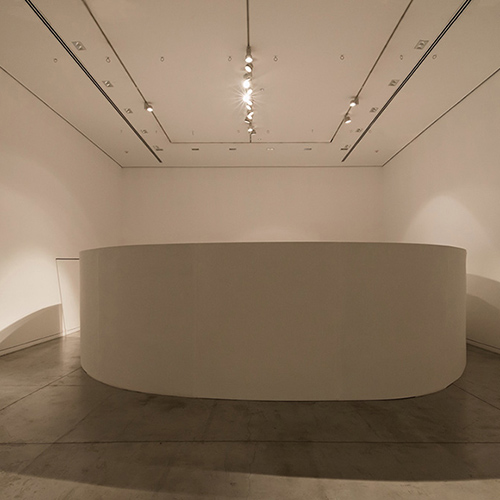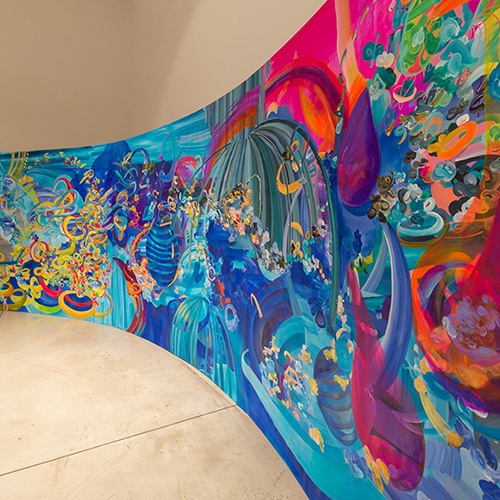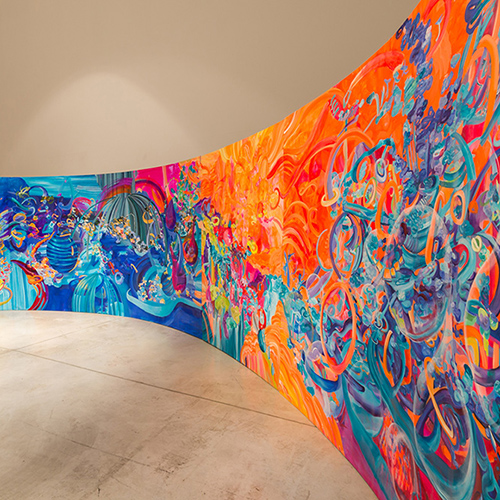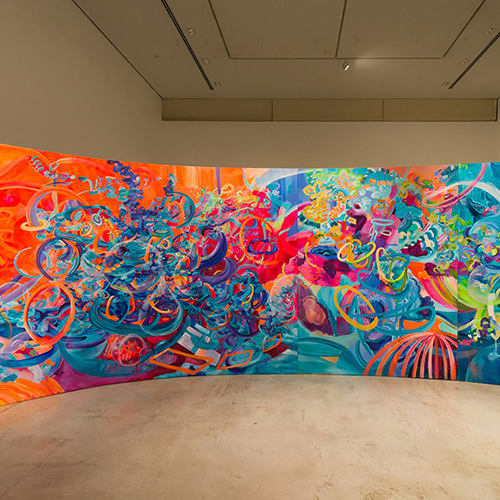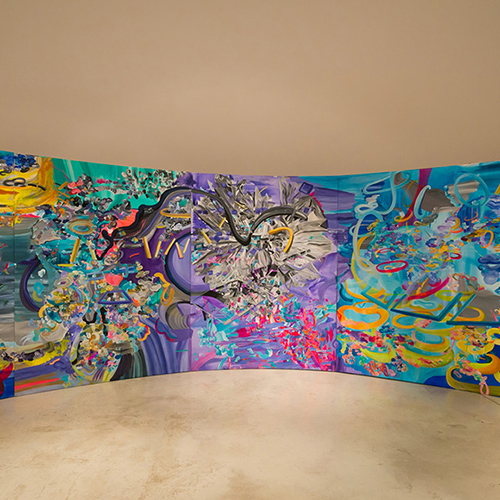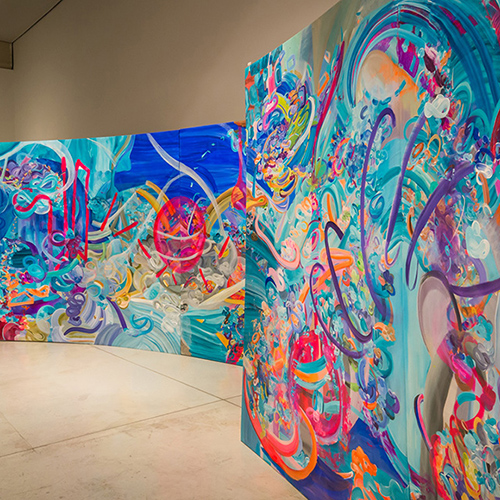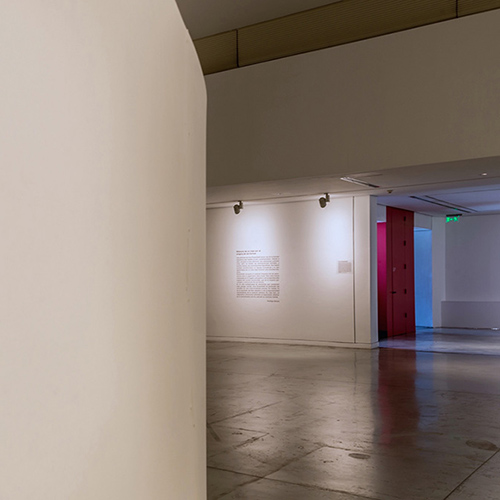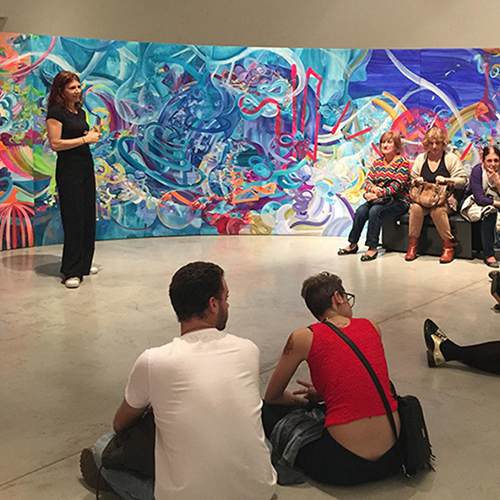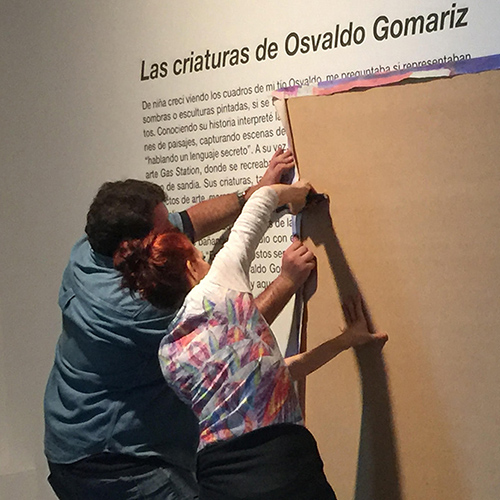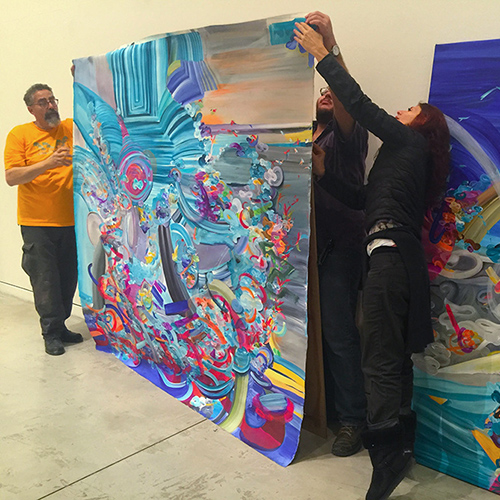"La vida se estructura como una linea, que es una forma de energía, en la cual hay una promesa de escape hacia un futuro.
Otras veces, se estructura en forma de loop, sin pasado ni futuro.
Hay una forma de escape pero no en este nivel de pensamiento".
Diedrich Diederichsen
"La vida se estructura como una linea, que es una forma de energía, en la cual hay una promesa de escape hacia un futuro.
Otras veces, se estructura en forma de loop, sin pasado ni futuro.
Hay una forma de escape pero no en este nivel de pensamiento".
Diedrich Diederichsen
Las pinturas de Irina Rosenfeldt hacen uso de la libertad expresiva que habilita el arte contemporáneo. Debido a esto, escapan a toda definición. Son abstractas a primera vista, pero no eluden las reminiscencias formales, y mucho menos, las connotaciones figurativas. Por momentos reclaman una respuesta sensorial o emotiva, pero de inmediato, sus infinitos trazos din?micos y flotantes son capaces de transportarnos hacia un paisaje mental, un torbellino de figuras evocativas o una galaxia en mutación permanente.
Para esto, Rosenfeldt extrema ciertas posibilidades de los recursos plásticos. Desestima la perspectiva renacentista que arrastra al espectador hacia las profundidades del punto de fuga, y con esto, logra que las formas se proyecten desde las telas hacia él, intensificándose en su cuerpo y su retina. Modula las variaciones de color entre los tonos cálidos y los fríos, construyendo un flujo cromático que acompaña al observador a lo largo de su recorrido por las extensas superficies pintadas. Elige una escala monumental que lo incorpora, y añade una estructura expositiva circular que lo lleva al interior de un dispositivo pictórico del que pareciera no tener escapatoria.
Estas decisiones ponen de manifiesto que para Irina Rosenfeldt la pintura no es sólo un medio productor de imágenes. Su necesidad de transmitir el impacto sensual de la materia, las formas y el color responde seguramente a su propia aproximación al medio con el cual trabaja, y que sin dudas la obsesiona. En su programa visual, la pintura se torna en una verdadera experiencia y en una invitación a percibir la fortaleza de un medio que mantiene su vitalidad a pesar de los continuos anuncios de su agotamiento.
La instalación que propone para el Museo Emilio Caraffa tiene su antecedente más notable en los panoramas que en el siglo XVIII provocaron las delicias del público londinense; unas extensas superficies pictóricas que podían tener hasta 15 metros de alto y 100 metros de longitud circular. Siendo la pintura el medio de representación de la realidad más exacto de la época, los panoramas fueron experiencias inmersivas, con un efecto cercano a aquello que hoy denominamos realidad virtual?. La ausencia de toda referencia externa hacía que las personas tuvieran la sensación de estar literalmente dentro de la obra, al punto de perder toda noción de su entorno inmediato y abandonarse plenamente a la aventura plástica. Estas producciones tuvieron un éxito extraordinario hasta que el desarrollo de la fotografía puso en evidencia sus limitaciones figurativas.
Irina Rosenfeldt recupera ese car?cter inmersivo de los panoramas para su gigantesca obra mural. Pero está menos interesada en el engaño perceptivo o en la reproducción realista del mundo reconocible, que en el impacto psicológico y emocional de sus lienzos.
Siendo una artista contemporánea, su trabajo se ubica a medio camino entre la pintura y la instalación, y otorga un papel más aut?nomo al espectador, que es inducido a construir su propia experiencia subjetiva. No hay un sentido particular por descubrir ni instrucciones para un encuentro correcto? con su propuesta. Hay, en cambio, una invitación a la exploración, la aprehensión sin prejuicios y la deriva personal.
Al mismo tiempo, Rosenfeldt plantea una suerte de rito de pasaje que fomenta una situación imprevisible. El exterior de la instalación aparece como una estructura de madera, cruda e irrelevante, que no anticipa en manera alguna lo que habita su interior.
Sólo cuando el espectador ha atravesado el umbral que lo introduce al espacio envolvente de la obra, cuando ya está rodeado por los torrentes dinámicos de las formas y el color, el volumen plástico se manifiesta en todo su esplendor, y todo su ser es empujado a la aventura estética. La palabra aventura? es absolutamente pertinente aquí porque es muy probable que el visitante no se haya enfrentado jamás a una ambientación de estas características, que lo arranca de la contingencia de la vida cotidiana y lo sumerge de manera literal? en la potencia de los efectos pictóricos.
Estos efectos lo interpelan tanto en el nivel sensorial como en el motriz. La obra exige ser transitada no solo con la mirada, sino también con la totalidad del cuerpo. El observador está llamado a desplazarse por el espacio ensayando una variedad de puntos de vista. Pero éstos no se manifiestan exclusivamente en el recorrido perimetral, en el movimiento a lo largo de la superficie dilatada de la tela, sino también, en su aproximación y alejamiento de ésta, que modifica de manera radical el enjambre de formas que pulsan sobre ella. En estos ajustes de distancia óptica, las manchas pueden transformarse en figuras evocadoras y lo que aparentaba ser un caos deja entrever una voluntad cósmica.
Porque en la vital multiplicidad de los trazos que componen este paisaje plural, Irina Rosenfeldt ha sembrado las semillas de una intencionalidad precisa. Su trabajo no es el resultado del libre albedrío ni de la espontaneidad momentánea de la creación artística. Es, más bien, un dispositivo emocional orientado al espectador, destinado a comunicarse con él, a instigarlo, a sacudir su universo mental. Un canal para incentivarlo a abandonarse en los territorios insondables de su propia imaginación.
is an immersive pictorial installation. An extra long painting shaped in a circular structure that contains a hidden Panorama with the following dimensions: 2 m x 28 m x 8 m in diameter. The outer area of the installation is in the shade, while the inside is illuminated. Arriving to the exhibition area, the installation is seen as a completely white structure.
The spectator can enter it through a 1.5 m opening space situated at the far end of the perimeter of the circle. Its essence, where the painting is, cannot be seen at first sight. The viewer must keep walking to acknowledge there is something going on inside a raw wall. Nothing indicates that within a structure so despoiled the viewer will enter a space of such colourfulness.
Once inside the circle, this circular montage occupies the complete and uninterrupted horizon of the spectators' gaze. The painting is an immense psychic landscape of vibrant colours, drawn with generous matter, violent and abundant gestures, centrifugal and centripetal forces and spatial constructions that interweave offering a kinaesthetic experience to those who face this enveloping frieze. An urgent, expanded and psychedelic painting that takes over and creates the space of the bodies that meet with it. Here there is a close encounter with the painting as a mental phenomenon and, furthermore, as a physical entity that is planted before us with all its intensity.
Irina Rosenfeldt's paintings make use of the expressive freedom that contemporary art enables. Because of this, they escape definition. They are abstract at first glance, but they do not avoid formal reminiscences, much less, figurative connotations. At times they demand a sensory or emotional response but, immediately after, their infinite dynamic floating strokes are able to transport us to a mental landscape, a whirlwind of evocative figures, or a galaxy in permanent mutation.
With this intent Rosenfeldt takes certain possibilities of the plastic resources to extremes. She neglects the Renaissance perspective that would draw the viewer to the depths of the vanishing point and by this she makes the forms project from the canvas to the viewer intensifying in his or her body and their retina. She modulates the colour variations from warm to cold tones constructing a chromatic flow that accompanies the observer along his route through the extensive painted surfaces.
The artist chooses a monumental scale that incorporates the viewer. At the far end of the salon, the massive white structure leads to the interior of a pictorial device from which there seems to be no escape. In her visual programme, painting becomes a true experience and an invitation to perceive the strength of a medium that maintains its vitality despite the continuous announcements of its exhaustion.
The installation proposed for the Museo Emilio Caraffa has its most notable antecedent in the panoramas that had caused ecstatic rapture in the eighteenth century London public. These extensive circular pictorial surfaces were sometimes up to 15 metres high and 100 metres long. With painting being the most exact medium to represent reality at the time, the panoramas became immersive experiences that caused an effect close to what we now call "virtual reality." The absence of external reference made people feel they were literally inside the work, to the point of losing notion of their immediate surroundings and abandoning themselves fully to the plastic adventure. These productions had an extraordinary success until the development of photography brought out their figurative limitations. Irina Rosenfeldt recovers the immersive character of those panoramas for her gigantic mural work.
But she is far less interested in perceptual deception or the realistic reproduction of a recognizable world than she is in the psychological and emotional impact of her canvases.
Being a contemporary artist, her work meets midway between painting and installation, and it gives a more autonomous role to the viewer, who is induced to build his or her own subjective experience. There is no particular manner to discover the way neither any instructions for a "correct" meeting with the experience. There is, instead, an invitation to explore, to take-in with unprejudiced apprehension, and, on a personal drift.
At the same time, Rosenfeldt raises a kind of rite of passage that promotes an unforeseeable situation. The exterior of the installation appears as a wooden structure, raw and irrelevant, and does not anticipate in any way what inhabits its interior. It is only when the spectator has crossed the threshold that he or she is fully surrounded by the dynamic torrents of forms and colour, plastic volume manifesting itself in all splendour, and the spectators? whole being is pushed to an aesthetic adventure. The word "adventure" is absolutely pertinent in this case, as it is likely that the visitor has never faced an environment of these characteristics before. This takes him or her out of the contingency of daily life and immerses them ?literally- in the power of the pictorial effects. These effects involve both their sensory and motor levels. The work demands to be travelled not only with the eye but, also, with the entire body. The observer is called to move through space rehearsing a variety of points of view. These views are not manifested exclusively in the perimetric course, when moving along the dilated surface of the cloth, but also in its approachment and distance from it. This radically modifies the swarm of forms that press upon the viewers? retina. In these adjustments of optical distances the spots can become evocative figures and what appeared to be chaos can suddenly suggest a cosmic will.
Because in the vital multiplicity of the traces that make up the plural landscape Irina Rosenfeldt has sown the seeds of a precise intentionality. Her work is not the result of free will or the momentary spontaneity of artistic creation. It is, rather, an emotional device oriented to the spectator, destined to communicate with him, to instigate him, to shake his mental universe. It is a channel to encourage the spectators to dwell in the unfathomable territories of their own imagination.
